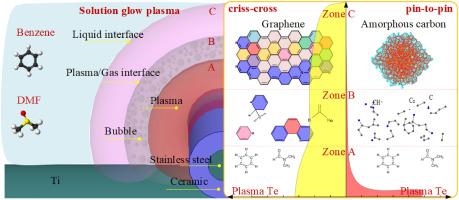Dielectric-barrier-stabilized solution plasma for high-nitrogen, few-layer graphene via low-temperature CN radical polymerization
IF 11.6
2区 材料科学
Q1 CHEMISTRY, PHYSICAL
引用次数: 0
Abstract
Nitrogen-doped graphene (NG) with high crystallinity and elevated nitrogen content is highly desirable for energy and catalytic applications, yet conventional high-temperature methods suffer from nitrogen volatilization, structural degradation, and metal contamination. Here, we report a dielectric-barrier-assisted criss-cross electrode configuration for solution plasma (SP) synthesis that achieves stable, low-temperature glow discharge in a benzene–DMF mixture. Finite-element simulations and optical diagnostics reveal that the dielectric barrier suppresses electron avalanches, producing a spatially uniform CN-rich plasma (∼2505 K) while minimizing C2 formation, thereby preserving aromatic integrity and limiting nitrogen loss. Compared to the conventional pin-to-pin SP, which generates high-temperature (∼5280 K), C2-dominated abnormal glow, the dielectric-stabilized system yields few-layer NG with markedly reduced defect density (ID/IG = 0.133), narrower 2D band (FWHM = 70 cm−1), and higher crystallinity. XPS analysis shows a nitrogen content of 12.22 at% with a high fraction of quaternary N (32.6 %), achieved without detectable metal carbide impurities. Mechanistic analysis suggests that the CN-rich plasma environment promotes polymerization of nitrogen-containing oligomers (e.g., CN·, C6H5·) into ordered graphene frameworks, providing a controllable pathway for tailoring both the structural and chemical properties of NG. Additional precursor tests (σ-bonded aliphatic, π-bonded aromatic, and extended conjugated molecules) further confirm the generality of this CN-driven mechanism. This work establishes a scalable, low-temperature, in-liquid plasma strategy for producing high-purity, nitrogen-rich graphene with tunable functionalities.

通过低温CN自由基聚合制备高氮、少层石墨烯的介质势垒稳定溶液等离子体
具有高结晶度和高氮含量的氮掺杂石墨烯(NG)在能源和催化应用中是非常理想的,但传统的高温方法存在氮挥发,结构降解和金属污染的问题。在这里,我们报道了一种用于溶液等离子体(SP)合成的介电势垒辅助交叉电极结构,该结构在苯- dmf混合物中实现了稳定的低温辉光放电。有限元模拟和光学诊断表明,介电屏障抑制了电子雪崩,产生了空间均匀的富cn等离子体(~ 2505 K),同时最大限度地减少了C2的形成,从而保持了芳香完整性并限制了氮的损失。与产生高温(~ 5280 K)、c2主导的异常发光的传统引脚对引脚SP相比,介质稳定体系产生的少层NG具有显著降低的缺陷密度(ID/IG = 0.133)、更窄的2D带(FWHM = 70 cm−1)和更高的结晶度。XPS分析表明,氮含量为12.22 at%,季氮含量较高(32.6%),未检测到金属碳化物杂质。机制分析表明,富CN等离子体环境促进含氮低聚物(如CN·,C6H5·)聚合成有序的石墨烯框架,为定制NG的结构和化学性质提供了一个可控的途径。前驱体实验(σ-键脂肪族分子、π-键芳香族分子和扩展共轭分子)进一步证实了这种碳驱动机制的普遍性。这项工作建立了一种可扩展、低温、液态等离子体策略,用于生产具有可调功能的高纯度、富氮石墨烯。
本文章由计算机程序翻译,如有差异,请以英文原文为准。
求助全文
约1分钟内获得全文
求助全文
来源期刊

Carbon
工程技术-材料科学:综合
CiteScore
20.80
自引率
7.30%
发文量
0
审稿时长
23 days
期刊介绍:
The journal Carbon is an international multidisciplinary forum for communicating scientific advances in the field of carbon materials. It reports new findings related to the formation, structure, properties, behaviors, and technological applications of carbons. Carbons are a broad class of ordered or disordered solid phases composed primarily of elemental carbon, including but not limited to carbon black, carbon fibers and filaments, carbon nanotubes, diamond and diamond-like carbon, fullerenes, glassy carbon, graphite, graphene, graphene-oxide, porous carbons, pyrolytic carbon, and other sp2 and non-sp2 hybridized carbon systems. Carbon is the companion title to the open access journal Carbon Trends. Relevant application areas for carbon materials include biology and medicine, catalysis, electronic, optoelectronic, spintronic, high-frequency, and photonic devices, energy storage and conversion systems, environmental applications and water treatment, smart materials and systems, and structural and thermal applications.
 求助内容:
求助内容: 应助结果提醒方式:
应助结果提醒方式:


